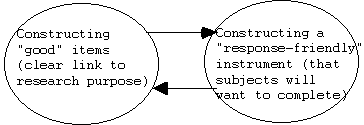 |
Survey Research
- Part I: Questionnaires and Survey Formats
Dear research cyber-fans: for the next three chapters, we'll be taking
an in-depth look at survey research. The use of surveys to collect data
is one of the most popular methods of (nonexperimental) educational research.
Thus, it warrants some special attention!
We'll start out with some tips for constructing questionnaire items.
***: I USE THE TERMS 'SURVEY' AND 'QUESTIONNAIRE' INTERCHANGEABLY.
Next, we'll take a look at two general 'families' of popular survey item
formats and the relative tradeoffs inherent in each one.
The material in this lesson is from William Wiersma's excellent text,
Research Methods in Education: An Introduction, 6th ed., 1994,
published by Allyn & Bacon.
Let's go!!!

Open and read the following link on Survey Research to get
your feet wet.
Survey Research 1
The individual
survey items should naturally link to, or emanate from, your set of
sub problems, research questions and/or hypotheses.
Some survey construction experts would go a step further and argue
that you shouldn't ask anything on your survey that does not specifically
link to a research question or sub problem. I see the wisdom of this
but have also worked with "astute, plan-ahead" doctoral students who've
asked more survey questions than they initially used in their dissertations!
Ah, and the "method to their madness" was this: wanting to grab this
chance to build as comprehensive and thorough a database as possible,
so as to "spin off" additional studies, papers, presentations, etc.,
after the dissertation is completed!
I agree with how Wiersma would characterize the choice: as the following balance:

Thus, it is optimal if you can achieve both goals simultaneously:
- asking all the questions you want to - "covering" your dissertation
needs & perhaps beyond;
- while at the same time, not making the questionnaire "too long," "dull
to complete" or the like - so that subjects will want to cooperate and
respond to all of the survey items that you have asked about.
Here, then, is Wiersma's 'tip sheet' for survey item construction
in general:
- Try to make items as clear and unambiguous as possible. Use terminology
that the subjects will understand. (Floyd Fowler, a name you'll
see mentioned later on, refers to this as "establishing a common
perceptual frame of reference" for the subjects. In a nutshell,
this helps ensure that "they'll read into it what you wrote into
it" and interpret a given word or phrase as you had intended - thereby
increasing reliability of responses. Example: "How many members
of your household do you have?" Some might count just immediate family
- i.e., parents, children, spouses. Others might count more distant
relatives if they are also living in that particular home. Another example:
"Which magazines do you subscribe to?" Does one count, say, TV Guide?
One doesn't 'read' it in the same way as other magazines; e.g., cover
to cover. Yet it is a periodical that can be purchased by subsription!).
Avoid vague words, technical terms, and jargon to the greatest extent
possible.
- Include only a single concept per item. (*** Qualitative friends!
We have already visited this issue in our discussion of writing "good"
interview questions! We suggested that you avoid "double-barreled" items,
or those which sound like one question but really contain two (or more)
embedded questions!) Example: "Are you in favor of minimum competency
testing and career ladder teacher incentive plans for newly hired teachers?"
How does one interpret, say, a "yes?" That the respondent agrees with
a) the testing; b) career ladders; or c) both?!
- Try to avoid the use of "leading" questions. These are questions
with implied assumptions or anticipated outcomes. Often, such
items indicate a 'preferred' response ... however subtly! Example: "Are
you in favor of relaxed discipline in the schools, even though such
discipline may undermine the moral development of youth?"
- Try to avoid questions that are "loaded" with social or professional
desirability. In essence, do not ask questions so that certain
responses would lead the respondents to 'disapprove of themselves.'
An example would be to ask a teacher: "Do you have difficulty maintaining
a positive learning environment in your classroom?"
- Try to avoid questions that demand 'personal' or 'delicate' information
- unless it is essential to the particular variables of your sub problems,
research questions, and/or hypotheses. Such items may range from questions
on exact age and income, to questions asking the respondent's extent
of involvement in illegal/immoral activities (i.e., drug use).
- Only request information that the subject is actually able to
provide. All items should "fit" the informational background of
the respondents. (Otherwise, the reliability of your study may suffer
due to misinterpretation, "guessing," skipping those items, etc.)
- Try to make the reading/comprehension level of the items appropriate
for the subjects. To the greatest extent possible, use "soft"
words as opposed to "hard" words. For example, when surveying teachers
you might opt for the 'more neutral' and 'less emotionally
loaded' terms of 'correction' or 'corrective action,' as opposed
to 'punishment' of students.
- All other things being equal:
- Shorter items are generally preferred to longer items;
&
- Simpler items are generally preferred to more complex items.
This would imply that, rather than opting for a single, detailed,
complex survey item, your best bet would be to try & break it up
into two (or more) shorter, more focused survey items.
- When requesting quantitative information, ask for a specific number
(i.e., an actual frequency), rather than an average. For example,
ask: "How often during the past month did you help your child with his/her
homework?" rather than, "On the average, how many times a month do you
help your child with his/her homework?"
- To the greatest extent possible:
- Avoid negatively worded items; &
- Do not use "double negatives." Example of "a:" "Which
of the following instructional strategies do you not use?"
- - -
Before leaving this topic of general survey guidelines, it is perhaps
even more important to consider the overall issue of whether or not
to construct one's own survey in the first place!
- Find and stick with an existing instrument? vs.
- Construct your own.
Proponents of #1 argue efficiency: why reinvent the wheel if
what you need is already out there!
And, this makes eminent sense IF what's out there also ideally fits
your individual needs (populations, key variables, research questions,
and so forth)!
If that is not the case, and/or if you cannot get the author's
permission to use or adapt his/her/their instrument to your unique needs
- > PLRSDR don't hesitate to design your OWN survey!
There's a subtle 'bias' that we often carry with regard to self-constructed
instrumentation. I sometimes refer to it as the "slick marketing packaging
bias." That is:
"Oh, gee, unless it's been 'done up and put together' by a big educational
research and testing firm, and piloted on 1,000's of cases across the
country, why, it won't be as rigorous!"
Not so! Quite the contrary: by developing, pilot-testing
and revising your own survey, as custom-tailored to your own unique
needs, research questions, subjects, settings - you are actually thereby
increasing its credibility and relevance - i.e., VALIDITY!
We'll be talking a bit more about pilot testing next time. Until then:
keep an open mind and trust your abilities to 'start from scratch' and
devise a survey that's right for you!
II: General Types of Survey Formats
There are two basic broad "families" or types of these:
- Selected-response/forced choice: where the subject chooses
from two or more options that are provide
Advantages:
- Enhances consistency of responses (since those choices
are spelled out, "already there" and sometimes even pre-defined
(e.g., what exactly is meant by "rural school setting");
-
Easier to tabulate and code these data into a database
- generally, code numbers can be pre-assigned to each choice,
thus making the database readily quantifiable and paving the way
for trained data-entry personnel to enter the survey responses
into the database;
- Somewhat easier and quicker for subjects to respond to
(as opposed to having to 'think through' and 'fill in, in their
own words'). Of course, as we've learned in Qualitative, 'ease of
response' may not necessarily be the best or only
objective. We may need and want the 'richness and depth of detail'
that would necessitate such 'think time and effort' on the part
of our subjects to be able to provide us with a response in their
own words. Still, ease and efficiency are two criteria that cannot
be overlooked in any survey design or construction issue. Whether
or not they are the primary criteria depend on the specific needs
and circumstances of the study. If they are key, then the fixed-choice
responses may be one way to attain these criteria.
Disadvantages:
- Due to the 'pre-existence' of the allowable choices, they
can sometimes 'box in' or constrain the respondents regarding the
breadth/richness/depth of the response (this can be partially
overcome by making sure there is as complete and relevant a list
of choices as possible - pilot testing can help here);
- Due to (a) above, construction of "good" fixed-choice items
may be relatively more time-consuming (including perhaps even
more than one pilot to ensure completeness, clarity, etc.) than
simply posing the same general question in open-ended format.
-
Open-ended items: for which the respondent
furnishes the response in his/her own words, being provided a blank
space on the survey to do so.
Advantage:
-
Such open-ended items allow relatively more
freedom of response, since respondents are free and welcome to
provide attitudes, perceptions, beliefs, etc., in their own words.
(*** Qualitative friends! You will recognize this as a golden
opportunity for "grounded theory," or allowing the key themes,
variables, concepts, etc. to emerge directly from the subjects
themselves rather than being 'pre-imposed' by the researcher.)
Disadvantages:
- Both questions and responses are sometimes subject to misinterpretation.
Different subjects may 'read different meanings' into a question;
and the researcher may similarly misperceive, misclassify, etc.,
the written open-ended responses. Such misinterpretation may greatly
hamper both the validity and reliability of the study.
-
Also, given the opportunity to 'respond in your own words,'
some subjects may include irrelevant information in a given
response.
-
This in turn increases the relative length of time needed
to sort, code, and classify such open-ended responses, as
compared with tabulating fixed-choice responses. As we have been
learning in our Qualitative cyber-adventure, there may be a great
deal of subjectivity inherent in creating and validating a coding
or classification scheme for one's qualitative data. This is not
necessarily a negative in and of itself; furthermore, established
procedures exist for increasing the 'credibility' of one's coding
scheme: i.e., extensively piloting the coding procedure with expert
judges beforehand, as well as using multiple raters and running
reliability (extent of coding agreement) checks. Still, such procedures
inherently increase the length of time, energy and commitment
of resources to the study.
- - -
The fixed-response and open-ended items should actually
be viewed as being on a continuum, rather than polar opposite, discrete
choices. One can, for instance, build in varying degrees of structure
into an open-ended item.
- For example, the following question would be seen as unstructured:
"What do you think of the honors program in mathematics?"
- > Please note the potential for grounded theory in the above,
qualitative fans! The researcher is allowing for either "kudos" or "gripes"
to "emerge," by not cuing for directionality. In addition, he/she (researcher)
is also not cuing for any particular aspect of the program. Rather,
the researcher is 'setting the stage' for the subject to choose: 1)
what part(s) or aspect(s) of the math honors program he/she wants
to mention; and 2) in what sense (as a positive, negative,
suggestion for improvement, etc.).
- Now, let's look at the same idea in partially structured form:
"What do you think about the effectiveness of the mathematics honors
program relative to advanced placement in college?"
Here, the researcher has 'prepicked' a particular aspect of the honors
program -- i.e., its relationship to future college placement -- and
is asking the subjects to evaluate its effectiveness. Again, 'anything
goes' with regard to directionality -- they are free to praise or 'bash'
the program!
-- but the "boundary" or "fence" has been set regarding which part
of the program they are to be thinking about and evaluating.
- Finally, here is a structured version of a related survey
item - please note the predetermined, selected-response format:
Do you feel that the present honors program in mathematics should be:
- continued without modifications?
- continued but modified?
- discontinued?
Such a structured, selected-response item would presumably be accompanied
and/or preceded by a clear operational definition of that particular
mathematics honors program. This would be done to, again, help ensure
what Floyd Fowler has termed a "common perceptual frame of reference"
for the respondents. They all understand exactly which program is being
referred to and that they are to be thinking of as they answer the related
questions.
In addition, for the totally structured format of the preceding item,
the directions would specify that the subject is to choose ONLY the
SINGLE response for each item which MOST CLOSELY represents his/her
opinion. There would be no latitude for any written-in responses.
(For partial structure, the subject might be asked to write in, say,
a brief rationale for his/her choice.)
- - -
Next time out, we'll continue our "survey odyssey" with a bit more
in-depth look at some subtypes of fixed-choice items. The most popular
of these is the Likert-scaled item. We'll also talk about the nature
and role of pilot-test procedures in establishing the validity and reliability
of questionnaire items. Along the way, we'll look at some tips for constructing
'good' cover letters in the case of mailed surveys. Finally, we'll 'carefully
confront' the hope (bane?!) of every survey researcher: issues involving
the response rate and problems of nonresponse bias.
- - -

Once you have finished you should:
Go on to Assignment
1
or
Go back to Survey
Research Part I: Inquiring Minds Want to Know: Questionnaires and Survey
Formats
E-mail M. Dereshiwsky at statcatmd@aol.com
Call M. Dereshiwsky at (520) 523-1892

Copyright © 1999 Northern Arizona
University
ALL RIGHTS RESERVED
|